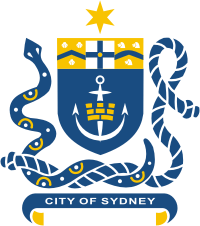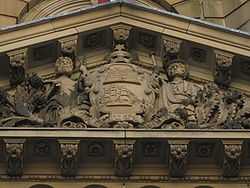Coat of arms of Sydney
| Corporate Logo of the City of Sydney | |
|---|---|
 | |
| Details | |
| Armiger | The Rt. Hon. Clover Moore, Lord Mayor of Sydney |
| Adopted | 1908 |
| Crest | anchor |
| Supporters | Aboriginal and Sailor |
| Motto | I take but I surrender |
The Corporate Logo of the City of Sydney was adopted by the City Council in 1996. It includes a graphic artist's 'version' of parts of the actual arms.
The blue shield features a crown and anchor, symbols which have long been the working images for Sydney. The white anchor represents Sydney as a port city on Sydney Harbour and the discovery of Australia by a naval officer. The gold masoned mural crown, common in many Commonwealth municipal arms, denotes the power and authority of a city.
The upper division of the shield features simplified versions of the three emblems in the upper part of the previous coat of arms, which together represent the naming of Sydney, the British contribution to Sydney's establishment and Sydney's emergence as a port city. The leftmost, with three white shells and a blue chevron on a gold background, is based on part of the arms of the man for whom the city was named, Thomas Townshend, 1st Viscount Sydney. Townshend played an important role as Principal Under-Secretary of State when Sydney was founded in 1788.

The central emblem, a blue cross on white overlaid with a yellow circle, was originally the red cross of the flag of England, which is also a significant feature of British Naval Flag, acknowledging the contribution of Captain Arthur Phillip. The yellow circle represents the globe which was a principal feature of the arms granted posthumously to Captain James Cook, the naval officer who discovered the east coast of Australia.
The top right emblem, containing three white lion heads and a blue chevron with a curved upper edge, is based on the arms of the first Lord Mayor of Sydney, Thomas Hughes, who first suggested that the city obtain a grant of arms.
The shield is supported by a serpent and a coiled rope. The serpent, in blue with white and gold markings, represents the Rainbow Serpent, a creator-being said to have formed the landscape in the Dreamtime as it travelled through the country. Its markings are based on those used by the Eora people, who lived in the area on which Sydney was founded. The rope continues the maritime imagery, and symbolises the diverse origins of the people of Sydney. The rope and serpent are intertwined, representing cultural harmony.
The crest is a six-pointed star or "Mullet of six points".
History
.jpg)
From 1857 until 1908, the City of Sydney used variations on a design for the city seal by draughtsman M. de St Remy. This design, for which the city never received an official grant of arms, featured a shield with a rising sun, a common symbol in early Australian heraldry representing the growth of the new colony, and a ship, representing Sydney's maritime heritage. The sun was later replaced with a beehive, a traditional symbol of industry. The shield was supported by a British seaman and an Indigenous Australian and the design included the motto "I take but I surrender".
After the position of Mayor become Lord Mayor in 1902, the first Lord Mayor, Thomas Hughes, suggested that the council apply for a grant of arms from the College of Arms in London. The heraldic designer William F. Ward submitted a new design, which included the ship, supporters and motto from the earlier version, but also included elements of the arms of Thomas Townshend and Captain Cook, as well as the crown, anchor and six-pointed star as a crest. The ship was now on a gold over blue background, symbolising the "Golden South". When the arms were approved by the heralds on 30 July 1908, the arms of Thomas Hughes had been added, along with a helmet and mantling above the shield.
The new arms adopted in 1996 simplified many elements of the 1908 arms, although the ship and motto were completely removed. The sailor and indigenous person were replaced with the modern style serpent and coiled rope, with their symbolism extended by the intertwining. The City still uses a banner of the 1908 arms as the official flag. As the current arms does not follow the original grant of arms, it is not in fact a proper coat of arms at all; more of a logo in the style of a coat of arms.
See also
- Flag of the City of Sydney
- Coat of arms of New South Wales
- City of Sydney
- Sydney (the wider metropolitan area)
References
| ||||||||||||||||||